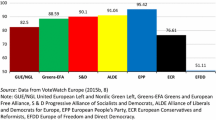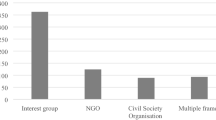Abstract
In recent decades, the emergence and development of pan-European civil society organisations have been prominent, including those representing interests of marginalised groups and raising related social issues. Typically composed of national and European level umbrella organisations, some of these organisations have grown as important interlocutors between EU institutions and civil society, and derive legitimacy for their advocacy and lobbying activities by claiming broad representativeness. Through a comparative study of five principal EU-based civil society organisations, the present article analyses how these organisations, operating at multiple levels with their membership based on extensive geographical areas, acquire internal representation of members and beneficiaries.
Résumé
Au cours des dernières décennies, l’émergence et le développement d’organisations paneuropéennes dans la société civile a constitué un phénomène de premier plan, y compris pour les organisations représentant les intérêts de groupes marginalisés ou celles mettant en avant les problèmes sociaux liés à ces groupes. Opérant typiquement sous l’égide d’organisations au niveau national et européen, certaines de ces organisations se sont développées au point de devenir des interlocuteurs importants entre les institutions de l’UE et la société civile et dérivent la légitimité de leurs activités militantes et de lobbying de leur revendication d’une représentativité large. Par le biais d’une étude comparative de cinq organisations majeures de la société civile basées dans l’UE, cet article analyse comment ces organisations, opérant à de multiples niveaux grace à la large répartition géographique de leurs membres, acquièrent une représentation interne de leurs membres et bénéficiaires.
Zusammenfassung
In den vergangenen Jahrzehnten waren die Entstehung und Entwicklung europaweiter Bürgergesellschaftsorganisationen von Bedeutung. Darin eingeschlossen sind Organisationen, die die Interessen von Randgruppen vertreten und auf soziale Probleme in diesem Zusammenhang aufmerksam machen. Einige der Organisationen, die sich in der Regel aus nationalen und europäischen Dachorganisationen zusammensetzen, haben sich zu wichtigen vermittelnden Gesprächspartnern zwischen den EU-Institutionen und der Bürgergesellschaft entwickelt. Sie banspruchen für sich eine weitreichende Repräsentation und leiten so ihre Legitimität für die Vertretung der Interessen anderer ab. Der vorliegende Beitrag analysiert mittels einer komparativen Untersuchung fünf wichtiger EU-Bürgergesellschaftsorganisationen, wie diese Organisationen, die auf mehreren Ebenen agieren und deren Mitgliedschaft sich über weitläufige geographische Regionen erstreckt, eine interne Repräsentation der Mitglieder und Zielgruppen erlangen.
Resumen
En décadas recientes, el surgimiento y desarrollo de organizaciones de la sociedad civil paneuropeas ha sido prominente, incluidas aquellas que representan los intereses de grupos marginados y que plantean cuestiones sociales relacionadas. Compuestas normalmente por organizaciones paraguas a nivel nacional y europeo, algunas de estas organizaciones han crecido convirtiéndose en importantes interlocutores entre las instituciones de la UE y la sociedad civil y obtienen legitimidad para sus actividades de defensa y presión política reclamando una amplia representatividad. Mediante un estudio comparativo de cinco organizaciones principales de la sociedad civil con base en la UE, el presente artículo analiza cómo estas organizaciones, que operan en múltiples niveles con sus miembros con base en extensas zonas geográficas, adquieren representación interna de los miembros y beneficiarios.
摘要
近十年来,整个欧洲的公民社会组织——包括代表边缘化群体的利益的组织——不断涌现,取得了令人瞩目的发展,也带来了一些相关的社会问题。这类组织以活动范围覆盖国内及欧洲的伞式组织为主,其中一些组织已经成为欧盟机构与公民社会的重要对话管道,并宣称具有广泛的代表性,以此作为其倡导及游说活动的合法性来源。通过对欧盟的五大公民社会组织进行对比研究,本分分析了这些活动范围各异、会员分布广泛的组织是如何取得对会员及受益人的内部代表资格的。.
ملخص
في العقود الأخيرة نشأة وتطور منظمات المجتمع المدني في البلاد الأوروبية أصبح بارز ، بما في ذلك تلك المصالح التي تمثل الفئات المهمشة ورفع القضايا الاجتماعية ذات الصلة. تتألف عادة من مظلة مستوى المنظمات الوطنية والأوروبية ، نمت بعض هذه المنظمات كمحاور مهمة بين مؤسسات الإتحاد الأوروبي والمجتمع المدني وتستمد الشرعية من أجل الدعوة وأنشطة الضغط الخاصة بهم من خلال زعم تمثيل واسع النطاق. من خلال دراسة مقارنة لخمسة منظمات مجتمع المدني رئيسية تعتمد على الإتحاد الأوروبي ، المقالة الحالية تحلل كيف يمكن لهذه المنظمات، أن تعمل على مستويات متعددة مع إعتماد عضويتها على مناطق جغرافية واسعة، الحصول على تمثيل داخلي للأعضاء والمستفيدين.
Similar content being viewed by others
References
Castiglione, D., & Warren, M. E. (2008). Rethinking democratic representation: Eight theoretical issues, Bellagio, September 30–October 3, 2008. Retrieved March 19, 2012, from http://www.democraciaparticipativa.org/bellagio/arquivos/Warren_RDR.pdf.
Charnovitz, S. (2006). Accountability of non-governmental organizations in global governance. In L. Jordan & P. Tuijl (Eds.), NGO accountability: Politics, principles and innovation. London: Earthscan.
Clarence, E. L., Jordan, G., & Maloney, W. (2005). Activating participation. In S. Rossteutscher (Ed.), Democracy and the role of associations: Political, organisational and social contexts. London: Routledge.
Cullen, P. (2003). Sponsored mobilization: European Union non-governmental organisations, international governance and activism for social rights. Ph.D. Dissertation, State University of New York at Stony Brook.
Dovi, S. (2008). Political representation. The Stanford Encyclopedia of Philosophy (Winter 2008 Edition), Edward N. Zalta (ed.), Standford Encyclopedia of Philsosophy, Retrieved March 19, 2012, from http://plato.stanford.edu/entries/political-representation/.
European Commission. (2000). Communication on strategic objectives (2000–2005) ‘Shaping the New Europe’, COM (2000) 154 Final. Commission of the European Communities, Brussels.
EAPN. (2009). Small steps—Big changes. Building participation of people experiencing poverty. Brussels: EAPN.
EDF. (2004). Statutes of the European disability forum. Retrieved March 19, 2004, from www.edf.feph.org.
ENAR. (2007). Statutes. Retrieved March 19, 2007, from www.enar-eu.org.
ENAR. (2011). Information leaflet. Retrieved March 19, 2011, from www.enar-eu.org.
EWL. (2009). Statutes. Retrieved March 19, 2009, from www.womenlobby.org.
FEANTSA. (2007). Participation tool-kit: Redistributing the power! October 2007. Retrieved March 19, 2012, from www.feantsa.org.
FEANTSA. Statutes. (Internal document).
Fox-Piven, F., & Cloward, A. (1977). Poor people’s movements. Why they succeed, how they fail. New York: Vintage Books.
Greenwood, J. (2007). Review article: Organized civil society and democratic legitimacy in the European Union. British Journal of Political Science, 37, 333–357.
Halpin, D. R. (2006). The participatory and democratic potential and practice of interest groups: Between solidarity and representation. Public Administration, 84(4), 919–940.
Johansson, H. (2012). Whom do they represent? Mixed modes of representation in EU-based CSOs. In S. Kröger & D. Friedrich (Eds.), The challenge of democratic representation in the European Union. New York: Palgrave Macmillan.
Kaldor, M. (2003). Civil society and accountability. Journal of Human Development, 4(1), 5–27.
Kendall, J. (Ed.). (2009). Handbook on third sector policy in Europe: Multi-level processes and organised civil society. Cheltenham: Edward Elgar Press.
Kohler-Koch, B. (2010). Civil society and EU democracy: ‘astroturf’ representation?’. Journal of European Public Policy, 17(1), 100–116.
Kohler-Koch, B., & Rittberger, B. (Eds.). (2007). Debating the democratic legitimacy of the European Union. Lanham: Rowman & Littlefield Publishers.
Kröger, S. (2008). Nothing but consultation: The place of organised civil society in EU policy-making across policies. European Governance Papers (EUROGOV) No. C-08-03.
Kröger, S., & Friedrich, D. (2012). Representation in the European Union: Coping with present challenges to democracy?. Houndmills: Palgrave Macmillan.
Mansbridge, J. (2003). Rethinking representation. American Political Science Review, 97(4), 515–528.
Mendoca, R. F. (2008). Representation and deliberation in civil society. Brazilian Political Science Review, 2(2), 117–137.
Pitkin, H. F. (1967). The concept of representation. Berkeley: University of California.
Rehfeld, A. (2005). The concept of constituency political representation, democratic legitimacy, and institutional design. Cambridge: Cambridge University press.
Saward, M. (2010). The representative claim. New York: Oxford University Press.
Saward, M. (2009). Authorisation and authenticity: Representation and the unelected. The Journal of Political Philosophy, 17(1), 1–22.
Saward, M. (2006). The representative claim. Contemporary Political Theory, 5(3), 297–318.
Severs, E. (2010). Representation as claims-making. Quid responsiveness? Representation, 46(4), 411–423.
Trenz, H. J. (2009). European civil society: Between participation, representation and discourse. Policy and Society, 28, 35–46.
Urbinati, N., & Warren, M. E. (2008). The concept of representation in contemporary democratic theory. Annual Review of Political Science, 11, 387–412.
Warleigh, A. (2001). Europeanizing civil society: NGOs as agents of political socialization. Journal of Common Market Studies, 39(4), 619–639.
Williams, M. S. (1998). Voice, trust, and memory: Marginalized groups and the failings of liberal representation. Princeton: Princeton University Press.
Young, I. M. (2000). Inclusion and democracy. Oxford: Oxford University Press.
Internet websites:
EAPN website, http://www.eapn.eu.
EDF website, http://www.edf-feph.org.
EWL website, http://www.womenlobby.org.
FEANTSA website, http://www.feantsa.org.
ENAR website, http://www.enar-eu.org.
Transparency register, http://europa.eu/transparency-register/index_en.htm.
Acknowledgments
This article is written as part of the research project ‘Beyond the welfare state: the Europeanization of Swedish Civil Society Organizations’, funded by the Swedish research council (ref no. 2010-1678). We would like to thank colleagues in the research project for insightful comments on previous drafts as well as anonymous reviewers.
Author information
Authors and Affiliations
Corresponding author
Rights and permissions
About this article
Cite this article
Johansson, H., Lee, J. Bridging the Gap: How do EU-Based Civil Society Organisations Acquire Their Internal Representation?. Voluntas 25, 405–424 (2014). https://doi.org/10.1007/s11266-012-9343-4
Published:
Issue Date:
DOI: https://doi.org/10.1007/s11266-012-9343-4




